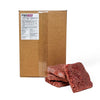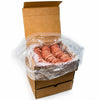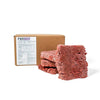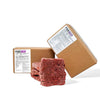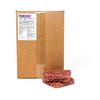Let's address one of the biggest misconceptions in modern pet nutrition: that raw or grain-free diets cause heart problems like dilated cardiomyopathy (DCM) or cardiomegaly.
The reality is more complex — and more concerning.
What the FDA Really Found on DCM and Grain-Free Diets:
In 2018, the FDA began investigating reports of DCM in dogs fed grain-free diets. But grain-free wasn’t the problem. What raised concern was that many of these diets:
- Replaced animal-based protein (meat, heart, organs)
- With plant-based protein (peas, lentils, legumes)
While still being heavily processed kibble - This isn’t “grain-free.” It’s meat-free in disguise.
According to FDA’s 2022 update and the peer-reviewed research they cite:
- 90% of the reported diets were dry kibble
- 93% contained peas or lentils as top ingredients
Many brands used concentrated plant proteins (like pea protein isolates) to meet protein requirements cheaply — not biologically appropriate for carnivores
FDA-Linked Studies Showing This Pattern:
1. Adin et al., 2019 – Echocardiographic Findings in Dogs Eating Diets Associated with DCM
Found that dogs eating grain-free, pea/lentil-heavy kibble showed structural heart changes that improved when switched to meat-rich diets.
2. Freeman et al., 2018 – Diet-Associated DCM in Dogs: What Do We Know?
Emphasized the link between DCM and legume-based kibble, not grain-free or raw feeding itself.
3. Kaplan et al., 2021 – Dietary Characteristics of Dogs with DCM
Identified that animal protein content was often lacking in diets associated with DCM.
So what’s the root issue?
A dogs heart, muscle, and immune systems depend on nutrients like:
Taurine, carnitine, arachidonic acid, vitamin B12
All found naturally in animal meat, organs, and connective tissue. When these are replaced by legumes, synthetic vitamins, and processed fillers, the risk of nutrient imbalance skyrockets — even if the diet is labeled “complete.”
Raw Feeding and Cardiomegaly
A properly balanced prey model raw diet (PMR):
- Provides natural taurine, carnitine, and essential amino acids
- Is free from processed plant proteins, synthetic preservatives, and legumes.
- Mirrors what dogs evolved to eat — not engineered to be shelf-stable for 2 years.
- There are zero peer-reviewed studies linking a balanced raw diet (especially PMR) to cardiomegaly or DCM.
The issue isn’t being “grain-free” — it’s being meat-deficient and legume-loaded.
Raw feeding, when done correctly, is not only safe — it’s biologically appropriate and protective for your dog’s long-term cardiac health.
Let’s Connect the Dots To Allergies and Inflammation:
From Peas, Lentils & other inflammatory ingredients → to Dysbiosis → to Leaky Gut → to Allergies, GI issues & more.
What is dysbiosis?
Dysbiosis is an imbalance in the gut microbiome — the diverse community of bacteria, fungi, and microbes that line your dog’s digestive tract. A healthy gut is the foundation of your dog’s immune system, nutrient absorption, and inflammation control.
When dysbiosis sets in, the gut wall becomes compromised, immune tolerance drops, and leaky gut (intestinal permeability) begins.
What Causes Dysbiosis in Kibble-Fed, Grain-Free Diets?
These are the top offenders — especially in plant-based or legume-heavy kibble:
1. Legumes & Peas (chickpeas, lentils, pea protein, etc.)
High in lectins – anti-nutrients that bind to the gut lining and disrupt microbial balance
High in oligosaccharides – fermentable fibers that feed gas-producing, inflammatory bacteria
Difficult for carnivorous guts to digest – leading to fermentation, bloating, and dysbiosis
Contain phytates that bind minerals (like zinc, magnesium) and prevent their absorption
2. Pea Protein & Other Isolates
These are highly concentrated, processed plant proteins
Lack the full amino acid profile of animal proteins
Disrupt the balance of proteolytic vs. saccharolytic bacteria — tipping the gut toward overgrowth of pathogenic microbes
3. Low Moisture + High Processing (Kibble)
Ultra-dry foods create a pro-inflammatory environment in the gut
Processing at high heat destroys delicate enzymes and beneficial compounds
Absence of raw enzymes and probiotics starves the gut microbiota
What Happens Next? Leaky Gut.
Once dysbiosis takes hold, the intestinal lining becomes inflamed and damaged.
This creates a “leaky” gut wall, where undigested food particles, toxins, and bacteria slip into the bloodstream.
The immune system now flags these as threats — leading to:
-
Chronic inflammation
-
Skin rashes
-
Itching, hotspots
-
Ear infections
-
Food sensitivities
-
Autoimmune flare-ups
Allergies are not the root problem — they’re a symptom of gut dysfunction.
How Raw Feeding Prevents This
A species-appropriate prey model raw diet (PMR):
-
Contains zero legumes, peas, or grains
-
Supports microbial diversity with raw enzymes and live probiotics
-
Nourishes the gut lining with glutamine, collagen, and healthy fats
-
Maintains a healthy pH and promotes balanced proteolytic bacteria
Dogs fed raw, meat-based diets are far less likely to suffer from dysbiosis, leaky gut, or allergy-like symptoms — because their gut is being fed the way nature intended.
Backed by Research
"Effects of legumes on gut barrier and inflammation" – found that excessive legumes promote gut permeability and inflammatory cytokines in animal models
Ref: Jiang W. et al., Food & Function, 2021
"Microbiome profile in dogs with food-responsive enteropathy" – noted that dysbiosis precedes food sensitivity and leaky gut in dogs
Ref: Cerquetella et al., Journal of Veterinary Internal Medicine, 2020
"Legumes as functional foods and the gut microbiome" – showed that legume-fed models had disrupted SCFA production and increased intestinal permeability
Ref: Singh et al., Nutrients, 2017
Final Word
If your dog is itching, inflamed, or developing new “allergies,” look beyond the surface.
It may not be what they’re reacting to, but what’s been happening inside — starting with a kibble that swapped meat for peas and labeled it “grain-free.”
Feed the gut what it’s designed to digest: meat, bone, organ, and nothing else.

